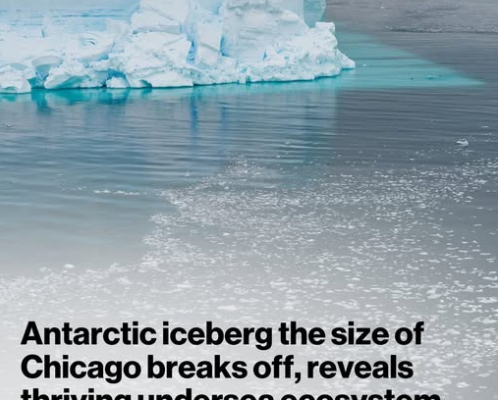Antarctic iceberg the size of Chicago breaks off, reveals thriving undersea ecosystem
Marine life may have existed in the region for centuries, say researchers.
An iceberg the size of Chicago that broke off of an Antarctic ice shelf has revealed a thriving ecosystem beneath it, according to researchers.
On Jan. 13, the iceberg, named A-84, broke off from the George VI Ice Shelf, a massive floating glacier attached to the Antarctic Peninsula ice sheet, according to the Schmidt Ocean Institute.

The seafloor beneath, previously covered by 209 square miles of ice, had never before been accessible to humans. A team of researchers aboard the Schmidt Ocean Institute’s R/V Falkor (too) oceanographic research vessel were working in the Bellingshausen Sea, on the west side of the Antarctic Peninsula, but dropped everything to make their way to the ice shelf. The pivot was described as a “serendipitous moment’ by Schmidt Ocean Institute Executive Director Jyotika Virmani.
“We seized upon the moment, changed our expedition plan, and went for it so we could look at what was happening in the depths below,” said Patricia Esquete, expedition co-chief scientist and biology researcher at the Centre of Marine and Environmental Studies, based in the U.S. Virgin Islands.
The team arrived at the site on Jan. 25 and observed the seafloor for eight days with the help of a remotely operated vehicle named SuBastian, which dove nearly a quarter mile to gather data on the geology, physical oceanography and biology of the never-before-explored underwater terrain.

Unexpectedly, they found a “beautiful, thriving ecosystem,” Esquete said. The significant biomass and biodiversity of the ecosystems surprised the researchers, especially since deep-sea ecosystems typically rely on nutrients from the surface that slowly trickle down to the seafloor – an unlikely occurrence when the sea surface is covered by 500-foot-thick ice. The marine scientists hypothesize that ocean currents may be responsible for moving life-sustaining nutrients to the ecosystem.
The species detected in the previously unknown ecosystem include large corals and sponges supporting a plethora of marine life, including icefish, giant sea spiders and octopuses, with several previously undiscovered species likely among them, the researchers said.

Based on the size of the animals, the communities have likely lived in that spot for decades, even hundreds of years, Esquete said.
Little is known about the seafloor beneath the floating ice shelves in Antarctica, according to the institute.
Over the last few decades, global warming has caused the Antarctic Peninsula ice sheet to shrink and lose mass, the researchers said. Satellite images released by NASA show the progression of the iceberg’s break from the George IV Ice Shelf from January through February 2025.

Antarctica is also home to the Thwaites Glacier, also known as the “Doomsday Glacier” due to its potential to contribute to severe global sea level rise, should it continue to melt.
“The ice loss from the Antarctic Ice Sheet is a major contributor to sea level rise worldwide,” said expedition co-chief scientist Sasha Montelli, a researcher at University College London.
The newly exposed seafloor allowed an international team of scientists to gather critical data about the past behavior of the larger Antarctic ice sheet. Autonomous underwater vehicles called gliders were also deployed to study the impacts of glacial meltwater on the physical and chemical properties of the region. Preliminary data shows a strong meltwater flow from the George IV Ice Shelf, according to the institute.
“Our work is critical for providing longer-term context of these recent changes, improving our ability to make projections of future change – projections that can inform actionable policies. We will undoubtedly make new discoveries as we continue to analyze this vital data,” Montelli said.



